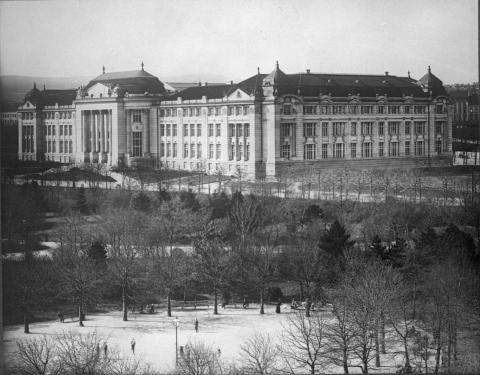The Technisches Museum Wien (TMW) was founded in 1908 on the sixtieth anniversary of the reign of Emperor Franz Joseph in 1908 on the initiative of representatives of industry and commerce and opened in May 1918 as a private museum. It was nationalized in 1922 and became answerable to the Ministry of Trade. The director from 1912 to 1930 was Ludwig Erhard, who after his retirement founded the Research Institute for the History of Technology at the TMW and headed it until his death in 1940. His successor was Viktor Schützenhofer, who was director of the museum from 1931 to 1949. Whereas the "alignment" of the museum under the Nazi regime in 1938 appeared to be unproblematic, a fierce debate erupted behind the scenes as to its future direction. From 1 August 1938, it became answerable to the Ministry of Internal and Cultural Affairs. Leading figures such as Ludwig Erhard, Heinrich Goldemund as president of the sponsoring association and Georg Günther as representative of the board sought to merge the TMW with the Hauptamt der Deutschen Technik and place it under the responsibility of the head of the Nationalsozialistisches Bund Deutscher Technik, Fritz Todt. Todt planned to found a Haus der Deutschen Technik in Munich that would be combined with the Deutsches Museum in Munich and the TMW. This would have enabled the NSDAP to exert a central influence on the presentation of science and technology in the German Reich. These plans were opposed by the state museum administration, which transferred responsibility for the TMW to the Dresden museum director Hans Kummerlöwe (1903–1995), who also directed the Naturhistorisches Museum and Museum of Ethnology in Vienna until 1945. The outbreak of war in September 1939 put a temporary end to the power struggle regarding the status of the TMW. Although the state and the NSDAP took little interest in it, the museum nevertheless became a focus of the party. In December 1941 an NSDAP functionary discovered that the panel in the museum stairway from the mid-1920s commemorating the founding of the museum contained the name of the Jewish industrialist Bernhard Wetzler and the Rothschild bank house. The panel was removed and replaced by a new one in April 1942. After the first heavy air raids in Vienna in mid-September 1944, the city's museums were partially closed. The TMW was now open only on Saturday afternoons and Sunday mornings and in the week only for guided tours. Although bombs landed nearby in 1944 and 1945, the building did not receive a direct hit.
On 14 October 1945, the TMW became the first Vienna museum to reopen to the public. The fifteen crates with objects from the museum stored in Hirschwang, Lower Austria, were returned with the aid of Soviet and French occupying troops between October 1945 and August 1946. By the end of 1946 the display objects stored in Vienna bank safes and the museum basement were also returned to their original place. According to director Schützenhofer, only two of the 20,000 secured objects were missing. The Constitutional Law on the Prohibition of the NSDAP called for the registration of all TMW staff, if affected by its regulations. Around one-third were deemed to be implicated, all men, since none of the eight women had been members of the NSDAP. The three "illegals", who had joined the NSDAP before March 1938, were suspended and none returned to the museum. The eight staff members who had applied for or held membership during the Nazi era were classified as "lesser offenders" and allowed to remain. The other staff were not regarded as being implicated. Two restitutions took place in the early 1960s: two coaches seized by the Gestapo in 1942 were returned to their legal owner, Theodor Schmidt; and the Marcus Car, which had been displayed on loan to the museum in 1918 and donated in 1938 by the provisional administrator of the ÖAMTC, was returned to the automobile club. After protracted negotiations, this decision was reversed and the car remained as a permanent loan in the museum. It was not until the promulgation of the Art Restitution Act in 1998 that a systematic investigation of the museum's inventory for objects expropriated under the Nazis was undertaken. Ten of the sixteen restitution cases to date have resulted in the return of objects to the heirs, some of which have been repurchased by the TMW. In the other cases, heirs have yet to be identified. Dossiers on the following collections have been submitted to the Art Restitution Advisory Board (in alphabetical order): Karl Banhans, Max Baczewski, Ernst Egger, Regine Ehrenfest-Egger, Hans Fischl, Siegfried Gerstl, Rosa Glückselig, Paul Herzfeld, Hugo Theodor Horwitz, Ernst Sonnenschein, Theodor Sternberg, Emil Stiassny, Theodor Wolf, and dossiers on letters from the western Ukrainian city of Kamenz Podolsk (Kamianets-Podilskyi), philately collections from the transfer of philately collections by the Provincial Tax Office for Vienna, Lower Austria and Burgenland, a radio seized by the Wehrmacht and a seized Austro Daimler ADR motor vehicle.

